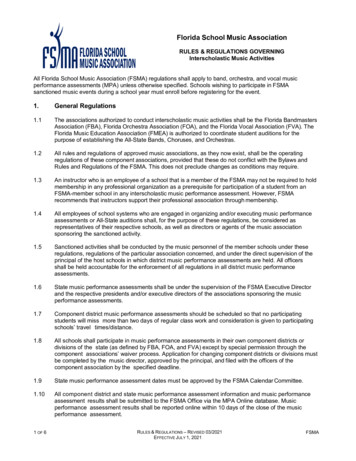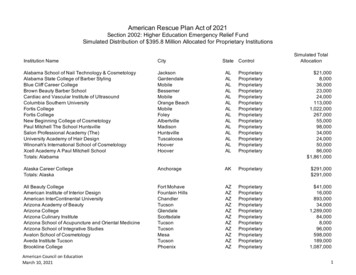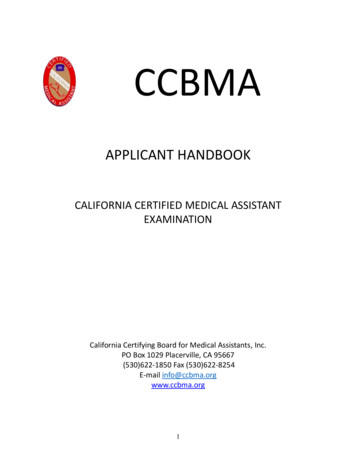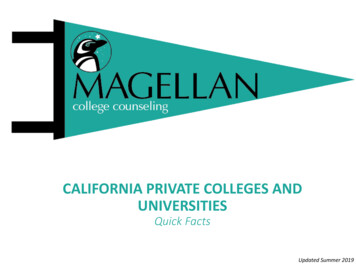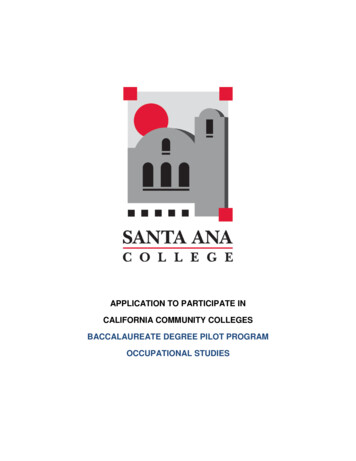
Transcription
APPLICATION TO PARTICIPATE INCALIFORNIA COMMUNITY COLLEGESBACCALAUREATE DEGREE PILOT PROGRAMOCCUPATIONAL STUDIES
TABLE OF CONTENTS1. Needa. Brief Description .2b. Description of the College and District .2c. Evaluation of Interest and Support .3d. Summary of Labor Market and Employer Demand .4e. Further Evidence of Need .42. Response to Needa. Description of Existing Programs .5b. Outline of Proposed Program .6c. Enrollment Projections and Anticipated Graduates .6d. Evidence of Program Innovation .7e. Proposed Curriculum .7f. Upper Division General Education Courses.8g. Timeline of Program .83. Program Management/Institutional Commitmenta. Accreditation Status .9b. Fiscal Management .9c. Program Administration and Support Staff .10d. Similar Programs .10e. Organizational Chart.104. Identified Resourcesa. Funding and Other Sources of Support.11b. Faculty and Student Support Services .11c. Facilities, Equipment, and Supplies .12d. Analysis of Success .125. Formsa. Signature Page (Appendix A) .131
NEEDBrief DescriptionThe baccalaureate program proposed by Santa Ana College (SAC) is OccupationalStudies. Occupational Therapy Education, consisting of Occupational Therapist (OT)and Occupational Therapy Assistant (OTA), is accredited by the Accreditation Councilfor Occupational Therapy Education (ACOTE). Currently, ACOTE is considering anelevation of the requirement for the entry level of OT from a Master’s degree to aDoctorate, with a recommended start date of 2025. The Council is also in paralleldiscussion regarding the enhancement of OTA from an Associate’s level to a Bachelor’slevel. Therefore, this proposal is in alignment with the ACOTE degree requirementsunder consideration. In addition, SAC is already committed to and offers an ACOTEapproved OTA program for lower division, which generates approximately 130 FTES (orfull-time equivalent students) each year, where students are able to graduate with anAssociate’s of science (AS) degree in OTA.1 With the large labor market demand in thisfield (as will be demonstrated later) coupled with the huge demand for this program, asevidenced by large wait lists of SAC students each semester, a pipeline already existsthat would further support creation of this proposed baccalaureate option for interestedstudents.This program has a twofold purpose: (1) it will create a more highly skilled assistant whois better able to understand and utilize research-based evidence for best practice; and(2) it will prepare an OTA for entry into an OT Master’s degree program. The expandedupper division course work would provide more in-depth training in specific areas ofpractice, including neurologic rehabilitation, musculoskeletal rehabilitation, mentalhealth, pediatrics, geriatrics, and emerging areas of practice. It would also provideincreased opportunities for critical analysis, research methods, and clinical reasoning.The program would culminate in a capstone seminar project and make the studentbetter prepared to work in tandem with an OT.Description of the College and DistrictSanta Ana College will celebrate one hundred years of service to students and thecommunity in 2015. The college offers a full complement of general education, transferlevel, pre-collegiate level, and career technical education classes leading to anAssociate’s degree or career/technical certificate. In addition, the second largest noncredit (adult education) program in the State is offered through the School of ContinuingEducation. Law enforcement professionals receive instruction through the OrangeCounty Sheriff’s Regional Training Center, and two off-campus fire technology trainingcenters provide students with hands-on experiences that simulate real-world conditions.The college currently includes 503,380 assignable square feet of space that alsofeatures a Digital Media Center, the first facility of its kind in Orange County, whichcombines education and business in the digital media industry. In fall 2014, SAC ges/default.aspx2
29,757 students (excluding positive attendance academy courses): 18,491 studentsenrolled in credit courses, while 11,266 students enrolled in non-credit.2Santa Ana College is part of the Rancho Santiago Community College District(RSCCD), one of the largest community college districts in California. In fall 2014,RSCCD served 40,653 students (excluding positive attendance academy courses):25,710 credit and 14,943 non-credit students.3 The district is represented by twocomprehensive colleges, consisting of a total of four centers and approximately 40 sitesunder the aegis of Santa Ana College, encompassing a total of 193 square miles andcomprising 24% of Orange County. The district service area and community arecomposed of six major cities within Orange County: Anaheim, Garden Grove, Orange,Santa Ana, Tustin, and Villa Park. Over one million residents live within RSCCDboundaries, and this number is projected to increase 6% by 2020 (Center forDemographic Research, 2012). Moreover, a population increase of four percentagepoints by 2020 is projected for Santa Ana (SAC’s primary service area).Evaluation of Interest and SupportIn the current OTA program, there had been a three-and-a-half-year wait list up to 2012.As a result, the application process was suspended at that point because the programwas so highly impacted. It was reopened from June 2014 through September 2014.Two hundred and forty-four qualified applicants applied for 55 openings.Community support is reflected in several ways. From 2004-2009, there were threeOTA programs at community colleges and one at a private university throughout theState of California. Job openings, however, exceeded the number of qualifiedgraduates. In order to meet community demand, within the proprietary college sector,one new accredited program opened in 2009; two are in the developing phase, and oneis in the applicant phase of the accreditation process. All feature high tuition rates.Another illustration of community support is that facilities in the community (e.g.,hospitals, school districts, skilled nursing facilities, mental health facilities, hand clinics)provide on-site clinical rotation opportunities for SAC students to fulfill their field workrequirements. Santa Ana College has over 100 contractual agreements with thesefacilities in the community (e.g., Rancho Los Amigos, Long Beach Memorial, St. Jude’s,Hallmark, Irvine Valley Unified School District, Santa Ana Unified School District,Gallagher Pediatric Clinic, Children’s Hospital Orange County, Miller Children’sHospital, Interface Rehabilitation, California Rehabilitation and Sports, Hands on Hands,County of San Bernardino, County of Los Angeles, Children’s Therapy Center, HealthSouth, the Greater Anaheim SELPA, Extended Care Hospital of Westminster, Allianceof Abilities).In addition, experts in the field volunteer to come to the college for guest lectures onspecialty topics such as driving evaluation for special needs drivers, at-risk youth,pediatric dysphagia, splinting, pediatric Neuro-Developmental Treatment (NDT), EnrollmentManagement/enrollmenttrendsfall2014.pdf3
seizure management. Students are also invited for field trips to facilities that offerspecialty areas of practice.Summary of Labor Market and Employer DemandAccording to Shatkin’s report entitled “150 Best Recession-Proof Jobs,” OTA ranked 72.In the same publication, OTA was ranked 24 of the 50 fastest-growing recession-proofjobs (JIST, 2008). In addition, according to the U.S. Bureau of Labor statistics, OTA isone of the 20 occupations with the highest percent (43%) change of employmentbetween 2012-2022.4 According to the California Development Department 2014 firstquarter statistics, the hourly mean is 31.98, with a range of 29.79 (25th percentile) to 36.04 (75th percentile).5 In addition, U.S. News & World Report cites the City of SantaAna, CA as one of the best-paying cities for OTA.6Fifty-three graduates responded to a 2012 survey, and of these, 78% reported findingwork within two weeks of their job search, and 66% reported that the starting salary wasgreater than 30.00 per hour. Jobs were acquired throughout Southern California,including Ventura, Los Angeles, Orange, San Bernardino, and Riverside Counties.Further Evidence of NeedThe profession of Occupational Therapy will celebrate its 100th anniversary in 2017. TheAmerican Occupational Therapy Association (AOTA) developed a centennial vision forthe occasion. The vision includes science driven and evidence based practice.Providing the OTA a Bachelor’s of Science (BS) degree in Occupational Studies willbetter prepare the OTA for this requisite science-based knowledge. Another componentof the vision is to provide evidence-based practice to demonstrate the efficacy of OTtreatment.One of the 2014 priorities to meet the centennial vision is to: “Provide strategic supportfor education, practitioners, and researchers to meet the rapidly changing societalneeds.” The BS degree would strive to meet this priority.The beauty of this program is that Occupational Studies BS recipients will be moreprofoundly trained as practitioners with a focus on direct patient care. Several growingpopulations will require OTA care in the near future. For example, as the “babyboomers” age, they will be facing a variety of challenges and areas that OT can providetreatment for, including low vision rehabilitation, older driver safety, alternativecommunity access, treatment strategies for dementia, and home modification toincrease safety as well as overall quality of life issues. Also, as we have medicaladvances in technology to save lives, from premature infants to those who havesustained major injury in an accident, we must also provide the treatment needed toenable people to have meaningful and productive sing/occExplorerQSDetails.asp?searchCriteria &careerID &menuChoice occExplorer&geogArea &soccode 312011&search Explore bs/occupational-therapy-assistant/salary4
RESPONSE TO THE NEEDDescription of Existing ProgramsThree community colleges in the State of California–Santa Ana College, GrossmontCollege, and Sacramento City College—are all impacted by increasing need for OTAtrained professionals. SAC has the largest existing Associate’s degree program of thethree.To enter the program at SAC, a student must complete four prerequisite courses (i.e.,Anatomy and Physiology, Freshman Composition, Communication Studies, andGeneral Psychology) with a grade of “C” or better. As part of the application process,students are also required to possess a current CPR card, a background check, andproof of immunizations. Two cohorts, 30 students each, are admitted per year for a totalof 120 students in the program. The curriculum is prescriptive, and the sequence ofcourses is developmental in a pathway. Students admitted in the fall have lectureclasses online and laboratory classes two evenings a week. In the third semester, theyalso attend Saturday classes. The students admitted in the spring have face-to-faceclasses scheduled back-to-back two days a week. The reason is to accommodatestudent need in terms of transportation, as students enter the program from throughoutSouthern California.The first three semesters consist of course work, and the last semester is comprised offull-time clinical rotations. In the first semester, the course work focuses on foundationalskills. This includes medical terminology, basic principles of philosophy of OT, activityanalysis, and human development across lifespan. The second semester providessome continued foundational information with applied kinesiology and human disease.The OT focus in the second semester is on psychosocial practice across lifespan. Thethird semester focuses on physical function and dysfunction across lifespan. Also in thethird semester, students are exposed to specialty areas of practice.Clinical rotations are an integral part of Occupational Therapy Education. In the secondsemester, students complete a 32-hour rotation in a psychosocial setting. In the thirdsemester, students complete a 32-hour rotation in a physical dysfunction setting. Thefourth semester consists of full-time clinical practice divided into 8-week rotations. Allfour field work experiences must be in different practice settings in order for the studentto develop entry level proficiency with a variety of patient populations.Of 300 students who entered the Santa Ana College OTA program between 2009-2013,two hundred and twenty-seven (75.6%) have graduated from the program. Within 11courses in the program in that same five-year period, completion and retention ratesranged between 90-100%.7 The National Board for Certification in OccupationalTherapy8 certification pass rate for students passing on the first attempt rangedbetween 81-90% for the years 2010-2012. In 2013, thirty-five students took the to2013CREDITbysubjectcourse.pdf8www.nbcot.org5
within one year of graduation, and the pass rate was 88%. In 2014, so far 61 studentshave passed the certification exam.Outline of Proposed ProgramThe current OTA program is centered around four themes: occupation; diversity; skillsand knowledge; and personal and professional development. The courses follow adevelopmental sequence by semester and are offered in a fixed pathway. Theproposed enhanced baccalaureate program will continue to focus on these themes andwould continue in an expanded developmental sequence. The baccalaureate programwould increase breadth and depth in all areas of clinical training provided in the existingtwo-year program. Areas included in greater depth are: specific clinical practicetechniques, healthcare ethics, cultural competency, application of research-basedevidence, documentation, and professional growth.The first two years of study focus on OTA education that specifically follows ACOTErequirements. The third year focuses on an advanced level of foundational skills toenable the student to understand concepts used in OT practice. The fourth yearprovides the student with specific skills when working with various patient populationsand areas of disability.The application process would remain the same for students entering the OTA program.Upon completion of the AS degree in OTA, the student may automatically continue intothe pathway of the BS program in Occupational Studies. In addition, past SAC OTAgraduates or students with an OTA degree from other accredited institutions may alsoapply for the baccalaureate program. Tuition at the community college level would beconsiderably less than a private institution to ensure equitable access and affordabilityto all prospective students.Enrollment Projections and Anticipated GraduatesAnticipated community support of the advanced-trained OTA will enable students tohave an advantage in the job market. Those students who wish to obtain a Master’sdegree would be better prepared on their pathway. In addition, the Bachelor’s degree atSAC would be significantly less expensive than an Associate’s degree at a proprietaryinstitution.The current pattern of enrollment is expected to persist as demand continues to grow.Considering the potential change in ACOTE requisite training for OTA to a BS degree,students would be likely to enroll in a BS program. Utilizing the cohort model as iscurrently used in the Associate’s degree program, the BS program would expand to 200students from the current 120 students program wide. The number of potentialgraduates per year would be maintained, with a potential of 200 graduates in five years.The difference is the level of preparation of each graduate who would be able to enterthe workforce with higher level skills. This would, in turn, increase the level of prestigefor the OTA throughout the community, with potential employers, and supervisingOccupational Therapists.6
Evidence of Program InnovationACOTE has only accredited the OTA program at the Associate’s level, and the 100standards for accreditation have only applied to this level.9 According to the list ofACOTE programs, formal OTA education has always been offered at communitycolleges, career-technical institutions, and private colleges. No UC or CSU has offeredthis program. OT, on the other hand, was offered at the Bachelor’s level until 2007,when it was enhanced to the Master’s level for entry into the profession. Currently, allaccredited OT programs are required at the Master’s or Doctorate level, not theBachelor’s level. In light of this, ACOTE is currently considering requiring a Bachelor’sdegree for OTA. This, coupled with the fact that SAC has a thriving AS-degree OTAprogram, is the reason the college has selected Occupational Studies for application toparticipate in the CCC Baccalaureate Degree Pilot Program.Proposed CurriculumIn practice, the OT supervises the OTA and is responsible for all client evaluations. OTeducation has had more focus on theory, evaluation, and research, while OTAeducation has had more focus on hands-on techniques needed to provide direct patientcare. The proposed program would continue to provide training in the skills needed forpatient care; however, this training would include more foundational information and bemore in-depth at both the theoretical level and the practical level.Due to time constraints at the Associate’s level, students are responsible for manytopics in a survey-type mode and have reported the need for more time to acquireconcepts properly. At the Bachelor’s level, several lectures may be presented on a topicinstead of just one, and the level of depth would promote more critical analysis andpractical application, aiding the student to develop both conceptually and practically.In the structure of the curriculum in the Associate’s program, each segment ofpsychosocial and physical dysfunction is presented across lifespan. In the proposedBachelor’s program, pediatrics and geriatrics would be taught in separate courses.Examples of areas taught in pediatrics include both psychosocial and physicaldysfunction: sensory integration, autism, attention deficit disorders, cerebral palsy, spinabifida, juvenile rheumatoid arthritis, muscular dystrophy, congenital limb deformities,development of hand skills, and postural control.Upper division courses would expand on specialty topics including assistive technologyand telerehabilitation; cognition and perception; and areas of advanced levels ofpractice – dysphagia, physi
Three community colleges in the State of California–Santa Ana College, Grossmont College, and Sacramento City College—are all impacted by increasing need for OTA-trained professionals. SAC has the largest existing Associate’s degree program of the three. To enter the program at SAC, a student must complete four prerequisite courses (i.e.,
